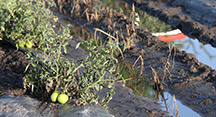Planning can help save vegetable crops from floodwaters
July 21, 2015
 |
|
Purdue Extension food safety specialist Scott Monroe points out that crops exposed to floods from waterways cannot be legally sold. (Purdue Agricultural Communication photo/Tom Campbell) |
WEST LAFAYETTE, Ind. - Purdue Extension food safety specialist Scott Monroe has developed a five-point plan to help Indiana's vegetable growers keep their produce safe from floodwaters spilling over from rain-swollen rivers, streams and creeks.
"Flooding and ponding in fields can cause food safety challenges and have the potential to introduce additional risk into the production system," Monroe said. "However, with proper management, many of these risks can be mitigated."
The Food and Drug Administration considers all food crops that have come into contact with floodwaters to be "adulterated" and not fit for human consumption. The agency advises producers to dispose of the flooded crops "in a manner that ensures they are kept separate from crops that have not been flood damaged."
The risk, Monroe said, is that floodwaters come from uncontrolled sources and could be contaminated by unknown substances, such as sewage or chemicals.
"Who knows what got in the water once it overflowed its banks," he said.
Ponding occurs when rainwater collects in low-lying areas. Long-term ponding can damage plants and the chances for contamination increase the longer ponded water stands in the field, Monroe said.
His recommendations for dealing with flooded areas:
* Document the extent of the flooding with photos and markers so the affected area is well defined even after the waters recede.
* Clear a 30-foot or larger buffer zone to isolate the flooded area and reduce the risk of edible crops becoming contaminated through splashing from rainwater or irrigation.
* If possible, avoid going through a flooded area to reach dry fields. Monroe says this helps ensure microbes don't "hitch a ride" into the harvestable area on boots, shoes or tires.
* Wear boots and gloves while working in flooded areas and be sure to thoroughly clean them afterward.
* All equipment used in flooded areas should also be thoroughly cleaned.
To read Monroe's full assessment of the flooding risk, download his article, "Food Safety Considerations for Flooded Vegetable Crops," in the current issue of Purdue's Vegetable Crops Hotline online newsletter at www.vegcropshotline.org.
Writer: Darrin Pack, 765-494-8415, dpack@purdue.edu
Source: Scott Monroe, 812-886-0198, jsmonroe@purdue.edu
Ag Communications: (765) 494-2722;
Keith Robinson, robins89@purdue.edu
Agriculture News Page

